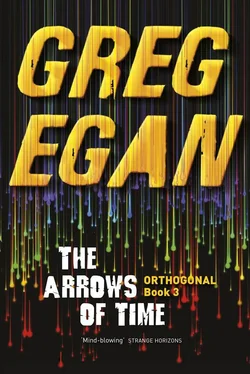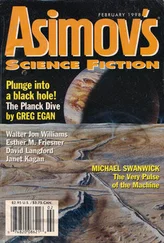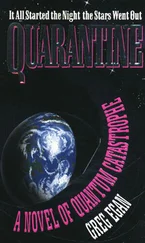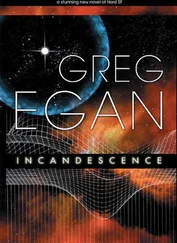Tarquinia said, ‘The good news is, the temperature looks tolerable. Hotter than we’re used to, but not by much.’
Agata was surprised. ‘How did you measure the temperature?’
‘The density profile of the atmosphere. A hotter atmosphere will stretch up farther from the surface.’
‘Is that reliable?’ Agata had no problem with the general idea, but she suspected that the method would be fraught with uncertainties.
‘I’m not sure,’ Tarquinia confessed. ‘I’ve never had a chance to observe a planet before.’
Ramiro said, ‘If this world’s come all the way around the cosmos, shouldn’t it have had time to grow hotter?’
‘No plants, no fires,’ Azelio pointed out. ‘If there’s nothing making light, there’s just slow geochemistry to warm it up.’
‘Ah.’ Ramiro turned to Agata. ‘Temperature doesn’t change when you swap the direction of time, does it?’
‘Not as such,’ Agata replied cautiously. ‘Imagine reversing the motion of all the particles in a container of gas: it wouldn’t make any difference.’
‘But if “temperature as such” is unchanged, what about the implications?’ Ramiro pressed her. ‘Will heat still flow from hot to cold?’
‘That depends on exactly what you’re talking about.’ Agata wasn’t trying to be unhelpful, but the worst thing she could do was make a blanket pronouncement that ignored the subtleties of the problem. ‘We ought to be able to find examples on Esilio where two lukewarm objects start out with the same temperature, but then heat flows from one to the other – making one cooler and the other hotter.’
Ramiro hummed impatiently. ‘That’s obvious: inasmuch as we’re able to act purely as spectators, we can expect to see ordinary things happening in reverse. But when we touch something down there, some rock that’s colder than our hands… ?’
Agata said, ‘Why do you expect there to be a simple answer to that: a rule that will hold true in every case? We’re used to predicting heat flows on the basis that entropy will increase along one direction in time — and the same principle will have held on Esilio for most of its history, for its own notion of the future. But the two arrows point in opposite directions, so each side’s rule flatly contradicts the other. Those rules were never universal laws, and this is the place where we finally have to accept that.’
‘But couldn’t the Esilian rock pass some of its heat to us, even if it’s colder?’ Azelio suggested. ‘Its entropy goes down, as we see it, while ours goes up. So both sides get to follow their usual rules.’
‘That’s not impossible,’ Agata agreed. ‘But we can’t expect to be able to partition everything as neatly as that. While we’re still far apart we can talk about the two sides and their rules… but deep down, matter is just matter, it doesn’t come with allegiances. The real laws of physics treat all directions in time and space identically, and they’re the laws that every photon and luxagen obeys — without knowing or caring about anything called entropy, let alone what side it’s meant to be on in some clash of thermodynamic arrows.
‘Suppose we leave a piece of equipment behind on Esilio – say, a small spyglass. Over the eons, from our point of view, we’d expect it to become pitted by dust in the wind, and eventually break up completely and turn to sand. Our spyglass, our rules: that sounds fair, doesn’t it? But if that sand stays on Esilio, what origin will it have from Esilio’s point of view? Most likely, some ordinary Esilian rock will have broken down to make it — which to us , would look like erosion running backwards. But then, in Esilian time the remnants of that rock will eventually form themselves spontaneously into a spyglass, which lies on the ground until we come along to retrieve it. So if you follow the history of the matter that makes up the spyglass far enough in both directions, it’s clear that it’s not committed to either side’s rules.’
Ramiro said, ‘That’s all very fascinating, but you still haven’t told me whether or not I’d burn myself by touching a cold rock.’
Tarquinia broke in. ‘No one will be touching anything until we’ve done enough experiments to know what’s safe and what isn’t.’
Ramiro gave up and dragged himself away, muttering about the uselessness of theoreticians.
Azelio caught Agata’s eye. ‘Your story about the spyglass was unsettling,’ he said, ‘but I’ll tell you what disturbs me more.’
‘What?’
‘Swap the roles of Esilio and the Surveyor ,’ he replied, ‘then tell the same story again. If something from Esilio takes the place of the spyglass, it must be with us already. We must have been carrying it, or the things that will become it, from the very start. Because according to Esilio’s arrow of time we’ve already visited the planet, and it’s almost certain that something remained with us when we departed.’
‘The black sun awaits your pleasure,’ Tarquinia announced from the doorway.
Agata looked up, startled. ‘Already?’
‘It’s now, or wait until we’re on our way back.’
‘Of course.’ Agata hesitated. ‘The telescope’s mine, until we switch orbits?’
‘Absolutely,’ Tarquinia replied. ‘But if you break it, you can grind a new lens.’
‘From what?’
‘The other part of your punishment will be hunting down suitable materials on Esilio.’
Agata could have done everything from her room, but that seemed selfish: the experiment belonged to all of them, and she wanted every member of the crew to feel free to look over her shoulder as she worked. So she dragged herself into the front cabin and strapped herself to her couch there.
Tarquinia had trained her to use the telescope’s software, but Agata still felt an illicit thrill when she invoked it from her own console and began passing it instructions through her corset. Since they’d shut off the engines the Surveyor had been sweeping in towards Esilio’s sun along a hyperbola, with the home cluster’s stars behind them. But as they swung around the sun in order to help them match velocities with Esilio she’d finally have a chance to juxtapose the two kinds of stars, with the dark mass in the foreground perfectly suited to its role.
Agata used the navigation system to map out the expected path of the black disc against an ordinary-light image of the sky. Then she chose two dozen points on various star trails that were destined to pass behind the sun, and measured their current positions with as much precision as the instruments allowed. The idea that gravity might distort the appearance of these trails wasn’t all that shocking – if it could bend the path of a planet into an ellipse, why wouldn’t it be able to nudge a beam of light? What was astonishing was the prospect of being able to distinguish between a force tugging on the light and curving its trajectory, and the light merely following the straightest possible history through a space that was itself curved.
Azelio harnessed himself to the couch beside her. ‘How do you know you won’t just be measuring an optical effect from the sun’s atmosphere?’ he challenged her.
‘I’ll need to include that in the final calculations,’ Agata conceded. ‘But there ought to be a point where the gravitational effects are showing up clearly, while the light’s still travelling far above the densest part of the atmosphere.’
‘Really? You’ve always talked about starlight “grazing the disc,” ’ Azelio protested.
‘I have, haven’t I?’ She’d been trying to stress that the lack of glare from the time-reversed sun would allow her to follow the stars right up to the moment they disappeared behind it. ‘But there’s nothing special about the light passing just above the surface – the effect doesn’t suddenly increase there. It’s the distance from the centre of the sun that counts, not the distance from its surface.’
Читать дальше










